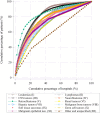Travel burdens to access care among children with cancer between 2016 and 2019: Analysis of a national population-based cancer registry in Japan
- PMID: 38625911
- PMCID: PMC11020387
- DOI: 10.1371/journal.pone.0300840
Travel burdens to access care among children with cancer between 2016 and 2019: Analysis of a national population-based cancer registry in Japan
Abstract
Background: Centralization of cancer care increases survival but increases the travel burden (i.e., travel durations, distances, and expenditures) in visiting hospitals. This study investigated the travel burdens to access cancer care for children aged 18 years and younger in Japan.
Methods: The study population comprised 10,709 patients diagnosed between 2016 and 2019 obtained from a national population-based cancer registry in Japan. Their residences were classified as urban or rural. We counted the number of patients treated at specialized hospitals and investigated the treatment centralization across diagnostic groups by Pareto plot. Travel burdens to access care were estimated using a route-planner web service and summarized using median values. A multivariable logistic model was performed to investigate factors associated with the events of car travel duration exceeding 1 h.
Results: Of the patients, 76.7% lived in urban areas, and 82.5% received treatment in designated hospitals for childhood cancer. The Pareto plot suggested that the top five hospitals treated 63.5% of patients with retinoblastoma. The estimated travel burdens for all patients were 0.62 h (0.57 h in urban areas and 1.00 h in rural areas), 16.9 km, and 0.0 dollars of toll charges. Regarding travel duration, 21.7% of patients had travel exceeding 1 h, and rural areas, retinoblastoma, malignant bone tumors, and childhood cancer-hub hospitals were associated with travel duration exceeding 1 h (adjusted odds ratios of 6.93, 3.59, 1.94, and 1.91, respectively).
Conclusions: Most patients were treated in specialized hospitals and the treatments for specific diseases were centralized. However, most patients were estimated to travel less than 1 h, and the travel burden tended to increase for patients in rural areas, those with specific diseases, and those going to specialized hospitals. Cancer control measures in Japan have steadily improved centralized treatment while keeping the travel burden relatively manageable.
Copyright: © 2024 Tsutsui et al. This is an open access article distributed under the terms of the Creative Commons Attribution License, which permits unrestricted use, distribution, and reproduction in any medium, provided the original author and source are credited.
Conflict of interest statement
The authors have declared that no competing interests exist.
Figures



Similar articles
-
[Residential areas, travel burdens, and children with cancer: Analysis of mobility and mortality ratios using data from Japan's national population-based cancer registry].Nihon Koshu Eisei Zasshi. 2025 May 29;72(5):331-339. doi: 10.11236/jph.24-086. Epub 2025 Jan 24. Nihon Koshu Eisei Zasshi. 2025. PMID: 39864842 Japanese.
-
Trends of travel burdens to access cancer care among children with cancer: analysis of a population-based cancer registry data in Aichi, Japan.Nagoya J Med Sci. 2023 Aug;85(3):542-554. doi: 10.18999/nagjms.85.3.542. Nagoya J Med Sci. 2023. PMID: 37829484 Free PMC article.
-
Driving to Childhood Cancer Hub Hospitals: A Study on Hospital Accessibility in Japan.Asian Pac J Cancer Prev. 2020 Jun 1;21(6):1725-1730. doi: 10.31557/APJCP.2020.21.6.1725. Asian Pac J Cancer Prev. 2020. PMID: 32592370 Free PMC article.
-
Geographic Access to Cancer Treatment in Japan: Results From a Combined Dataset of the Patient Survey and the Survey of Medical Institutions in 2011.J Epidemiol. 2018 Nov 5;28(11):470-475. doi: 10.2188/jea.JE20170051. Epub 2018 May 12. J Epidemiol. 2018. PMID: 29760321 Free PMC article.
-
Does Hypothetical Centralization of Revision THA and TKA Exacerbate Existing Geographic or Demographic Disparities in Access to Care by Increased Patient Travel Distances or Times? A Large-database Study.Clin Orthop Relat Res. 2022 Jun 1;480(6):1033-1045. doi: 10.1097/CORR.0000000000002072. Epub 2021 Dec 21. Clin Orthop Relat Res. 2022. PMID: 34870619 Free PMC article.
Cited by
-
Geographical Discrepancy in Medical Care Access Among Children, Adolescents, and Young Adults With Cancer in Japan, 2016-2019.Cancer Sci. 2025 Jul;116(7):1972-1983. doi: 10.1111/cas.70069. Epub 2025 Apr 2. Cancer Sci. 2025. PMID: 40172550 Free PMC article.
References
MeSH terms
LinkOut - more resources
Full Text Sources

